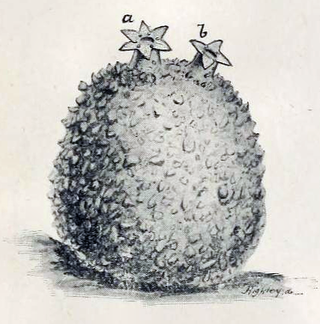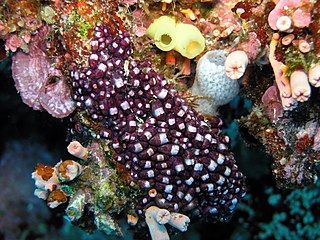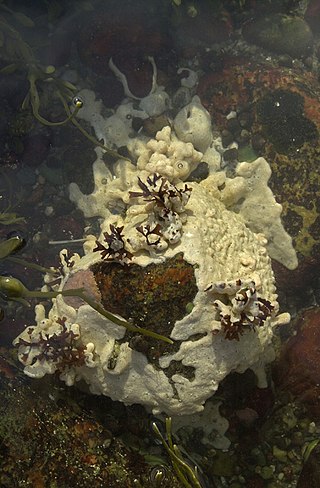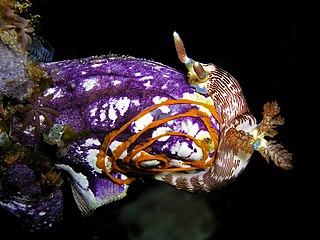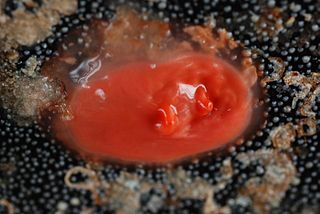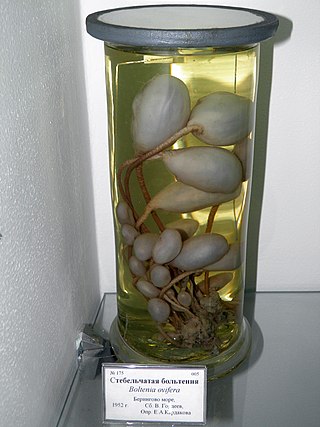| Styela | |
|---|---|
 | |
| Styela montereyensis | |
| Scientific classification | |
| Domain: | Eukaryota |
| Kingdom: | Animalia |
| Phylum: | Chordata |
| Subphylum: | Tunicata |
| Class: | Ascidiacea |
| Order: | Stolidobranchia |
| Family: | Styelidae |
| Genus: | Styela Fleming, 1822 |
| Species | |
See text | |
Styela is a genus of tunicates. Styela clava , an edible species, is known as an invasive species in some areas.
Species include: [1]
- Styela adriatica F. & C. Monniot, 1976
- Styela aequatorialis Michaelsen, 1915
- Styela angularis (Stimpson, 1855)
- Styela aomori Oka, 1935
- Styela argillacea Sluiter, 1900
- Styela asterogama Millar, 1975
- Styela bathybia Bonnevie, 1896
- Styela brevigaster Millar, 1988
- Styela calva Monniot C., Monniot F. & Millar, 1976
- Styela canopus (Savigny, 1816)
- Styela chaini Monniot C. & Monniot F., 1970
- Styela changa Monniot & Andrade, 1983
- Styela charcoti Monniot C. & Monniot F., 1973
- Styela clava Herdman, 1881 [2] [3]
- Styela clavata (Pallas, 1774)
- Styela complexa Kott, 1995
- Styela coriacea (Alder & Hancock, 1848)
- Styela crinita Monniot C. & Monniot F., 1973
- Styela eurygaster Millar, 1977
- Styela gagetyleri Young & Vazquez, 1997
- Styela gelatinosa (Traustedt, 1886)
- Styela gibbsii Stimpson, 1864
- Styela glans Herdman, 1881
- Styela glebosa Sluiter, 1904
- Styela hadalis Sanamyan & Sanamyan, 2006
- Styela herdmani Sluiter, 1885
- Styela izuana (Oka, 1934)
- Styela kottae Monniot & Monniot, 1991
- Styela loculosa Monniot C. & Monniot F., 1969
- Styela longiducta Monniot & Monniot, 1985
- Styela longipedata Tokioka, 1953
- Styela longitubis Traustedt & Weltner, 1894
- Styela macrenteron Ritter, 1913
- Styela maeandria Sluiter, 1904
- Styela magalhaensis Michaelsen, 1898
- Styela mallei Monniot, 1978
- Styela materna Monniot & Monniot, 1983
- Styela meteoris Monniot, 2002
- Styela minima Monniot, 1971
- Styela monogamica Oka, 1935
- Styela montereyensis (Dall, 1872)
- Styela multitentaculata Sanamyan & Sanamyan, 2006
- Styela natalis Hartmeyer, 1905
- Styela ordinaria Monniot & Monniot, 1985
- Styela paessleri (Michaelsen, 1898)
- Styela perforata Sluiter, 1890
- Styela pfefferi Michaelsen, 1898
- Styela plicata (Lesueur, 1823) [4]
- Styela polypes Monniot, Monniot & Millar, 1976
- Styela profunda Sluiter, 1904
- Styela psammodes Sluiter, 1904
- Styela psoliformis Monniot & Monniot, 1989
- Styela rustica Linnaeus, 1767
- Styela schmitti Van Name, 1945
- Styela sericata Herdman, 1888
- Styela sigma Hartmeyer, 1912
- Styela similis Monniot C., 1970
- Styela squamosa Herdman, 1881
- Styela subpinguis Herdman, 1923
- Styela suluensis Monniot & Monniot, 2003
- Styela talpina Monniot, 1978
- Styela tenuibranchia Monniot, Monniot & Millar, 1976
- Styela tesseris Lambert, 1993
- Styela thalassae Monniot C., 1969
- Styela theeli Ärnbäck, 1922
- Styela tholiformis (Sluiter, 1912)
- Styela tokiokai Nishikawa, 1991
- Styela truncata Ritter, 1901
- Styela uniplicata Bonnevie, 1896
- Styela wandeli (Sluiter, 1911)
- Styela yakutatensis Ritter, 1901
Species names currently considered to be synonyms:
- Styela aggregataTraustedt, 1880: synonym of Styela coriacea (Alder & Hancock, 1848)
- Styela albomarginataSluiter, 1904: synonym of Polycarpa obscura Heller, 1878
- Styela ambonensisSluiter, 1904: synonym of Polycarpa ambonensis (Sluiter, 1904)
- Styela anguineaSluiter, 1898: synonym of Polycarpa anguinea (Sluiter, 1898)
- Styela apalinaAlder & Hancock, 1907: synonym of Polycarpa pomaria (Savigny, 1816)
- Styela appropinquataSluiter, 1898: synonym of Polycarpa appropinquata (Sluiter, 1898)
- Styela arcticaSwederus, 1887: synonym of Dendrodoa aggregata Müller, 1776
- Styela areolataHeller, 1878: synonym of Cnemidocarpa areolata (Heller, 1878)
- Styela argentataSluiter, 1890: synonym of Polycarpa argentata (Sluiter, 1890)
- Styela armataLacaze-Duthiers & Delage, 1892: synonym of Styela coriacea (Alder & Hancock, 1848)
- Styela ascidioidesHerdman, 1906: synonym of Polycarpa olitoria (Sluiter, 1890)
- Styela asiphonicaSluiter, 1898: synonym of Polycarpa insulsa (Sluiter, 1898)
- Styela asymmetra(Hartmeyer, 1912): synonym of Asterocarpa humilis (Heller, 1878)
- Styela atlantica(Van Name, 1912): synonym of Styela sigma Hartmeyer, 1912
- Styela aurata(Quoy & Gaimard, 1834): synonym of Polycarpa aurata (Quoy & Gaimard, 1834)
- Styela auritaSluiter, 1890: synonym of Polycarpa aurita (Sluiter, 1890)
- Styela barbarisKott, 1952: synonym of Styela canopus (Savigny, 1816)
- Styela barnhartiRitter & Forsyth, 1917: synonym of Styela clava Herdman, 1881 [5]
- Styela bathyphila(Millar, 1955): synonym of Cnemidocarpa bathyphila Millar, 1955
- Styela bermudensisVan Name, 1902: synonym of Styela canopus (Savigny, 1816)
- Styela bicolor(Sluiter, 1887): synonym of Styela canopus (Savigny, 1816)
- Styela bicornutaSluiter, 1900: synonym of Cnemidocarpa bicornuta (Sluiter, 1900)
- Styela biforisSluiter, 1904: synonym of Polycarpa biforis (Sluiter, 1904)
- Styela brevipedunculataSluiter, 1898: synonym of Polycarpa spongiabilis Traustedt, 1883
- Styela bythiaHerdman, 1881: synonym of Cnemidocarpa bythia (Herdman, 1881)
- Styela canopoidesHeller, 1877: synonym of Styela canopus (Savigny, 1816)
- Styela captiosaSluiter, 1885: synonym of Polycarpa papillata Sluiter, 1885
- Styela cartilagineaSluiter, 1898: synonym of Polycarpa cartilaginea (Sluiter, 1898)
- Styela cereaSluiter, 1900: synonym of Asterocarpa humilis (Heller, 1878)
- Styela circumarataSluiter, 1904: synonym of Polycarpa aurita (Sluiter, 1890)
- Styela claraHartmeyer, 1906: synonym of Cnemidocarpa clara (Hartmeyer, 1906)
- Styela coerulea(Quoy & Gaimard, 1834): synonym of Asterocarpa coerulea (Quoy & Gaimard, 1834)
- Styela comata(Alder, 1863): synonym of Polycarpa comata (Alder, 1863)
- Styela conicaSwederus, 1887: synonym of Styela coriacea (Alder & Hancock, 1848)
- Styela contectaSluiter, 1904: synonym of Polycarpa contecta (Sluiter, 1904)
- Styela convexaHerdman, 1881: synonym of Cnemidocarpa drygalskii (Hartmeyer, 1911)
- Styela costata(Hartmeyer, 1911): synonym of Styela angularis (Stimpson, 1855)
- Styela cryptocarpaSluiter, 1885: synonym of Polycarpa obscura Heller, 1878
- Styela curtzeiMichaelsen, 1900: synonym of Cnemidocarpa nordenskjöldi (Michaelsen, 1898)
- Styela cylindricaBonnevie, 1896: synonym of Styela coriacea (Alder & Hancock, 1848)
- Styela cylindriformisBonnevie, 1896: synonym of Styela coriacea (Alder & Hancock, 1848)
- Styela depressaAlder & Hancock, 1907: synonym of Polycarpa tenera Lacaze-Duthiers & Delage, 1892
- Styela doliolumBjerkan, 1905: synonym of Styela gelatinosa (Traustedt, 1886)
- Styela drygalskii(Hartmeyer, 1911): synonym of Cnemidocarpa drygalskii (Hartmeyer, 1911)
- Styela elata(Heller, 1878): synonym of Polycarpa papillata Sluiter, 1885
- Styela elsaHartmeyer, 1906: synonym of Cnemidocarpa clara (Hartmeyer, 1906)
- Styela estherHartmeyer, 1906: synonym of Cnemidocarpa irene (Hartmeyer, 1906)
- Styela etheridgiiHerdman, 1899: synonym of Cnemidocarpa radicosa (Herdman, 1882)
- Styela fertilisHartmeyer, 1906: synonym of Cnemidocarpa fertilis (Hartmeyer, 1906)
- Styela fibrillataAlder & Hancock, 1907: synonym of Polycarpa comata (Alder, 1863)
- Styela finmarkiensis(Kiaer, 1893): synonym of Cnemidocarpa finmarkiensis (Kiaer, 1893)
- Styela flavaHerdman, 1881: synonym of Styela squamosa Herdman, 1881
- Styela flexibilisSluiter, 1905: synonym of Cnemidocarpa verrucosa (Lesson, 1830)
- Styela floccosaSluiter, 1904: synonym of Cnemidocarpa floccosa (Sluiter, 1904)
- Styela friabilisSluiter, 1898: synonym of Polycarpa spongiabilis Traustedt, 1883
- Styela fuligineaSluiter, 1898: synonym of Polycarpa spongiabilis Traustedt, 1883
- Styela gracilocarpaMillar, 1982: synonym of Styela squamosa Herdman, 1881
- Styela grahamiSluiter, 1905: synonym of Dicarpa insinuosa (Sluiter, 1912)
- Styela grandisHerdman, 1881: synonym of Cnemidocarpa verrucosa (Lesson, 1830)
- Styela granulata(Alder, 1863): synonym of Polycarpa pomaria (Savigny, 1816)
- Styela greeleyi(Ritter, 1899): synonym of Styela clavata (Pallas, 1774)
- Styela grossularia(Beneden, 1846): synonym of Dendrodoa grossularia (Van Beneden, 1846)
- Styela gyrosaHeller, 1877: synonym of Styela plicata (Lesueur, 1823)
- Styela hemicaespitosaRitter, 1913: synonym of Styela coriacea (Alder & Hancock, 1848)
- Styela humilisHeller, 1878: synonym of Asterocarpa humilis (Heller, 1878)
- Styela hupferi(Michaelsen, 1904): synonym of Distomus hupferi (Michaelsen, 1904)
- Styela incubitaSluiter, 1904: synonym of Cnemidocarpa incubita (Sluiter, 1904)
- Styela informisForbes, 1848: synonym of Polycarpa pomaria (Savigny, 1816)
- Styela insinuosa(Sluiter, 1912): synonym of Dicarpa insinuosa (Sluiter, 1912)
- Styela insulsaSluiter, 1898: synonym of Polycarpa insulsa (Sluiter, 1898)
- Styela ireneHartmeyer, 1906: synonym of Cnemidocarpa irene (Hartmeyer, 1906)
- Styela irma(Hartmeyer, 1927): synonym of Cnemidocarpa irene (Hartmeyer, 1906)
- Styela joannaeHerdman, 1898: synonym of Cnemidocarpa clara (Hartmeyer, 1906)
- Styela krobojaOka, 1906: synonym of Polycarpa obscura Heller, 1878
- Styela lacteaHerdman, 1881: synonym of Cnemidocarpa verrucosa (Lesson, 1830)
- Styela lapidosa(Herdman, 1891): synonym of Polyandrocarpa lapidosa (Herdman, 1891)
- Styela lineataTraustedt, 1880: synonym of Dendrodoa lineata (Traustedt, 1880)
- Styela lobataKott, 1952: synonym of Cnemidocarpa lobata (Kott, 1952)
- Styela longataKott, 1954: synonym of Cnemidocarpa longata (Kott, 1954)
- Styela loveni(Sars, 1851): synonym of Styela coriacea (Alder & Hancock, 1848)
- Styela lovenii(Sars, 1851): synonym of Styela coriacea (Alder & Hancock, 1848)
- Styela macrogastraOka, 1935: synonym of Styela coriacea (Alder & Hancock, 1848)
- Styela maculataSanamyan, 1992: synonym of Styela squamosa Herdman, 1881
- Styela maendriaSluiter, 1904: synonym of Styela maendria [ check spelling ]Sluiter, 1904
- Styela maendriaSluiter, 1904: synonym of Styela maeandria Sluiter, 1904
- Styela mammiculataCarlisle, 1954: synonym of Styela clava Herdman, 1881
- Styela maroccanaSluiter, 1927: synonym of Cnemidocarpa irene (Hartmeyer, 1906)
- Styela marquesanaMichaelsen, 1918: synonym of Styela canopus (Savigny, 1816)
- Styela melincaeÄrnbäck, 1929: synonym of Styela magalhaensis Michaelsen, 1898
- Styela milleriRitter, 1907: synonym of Styela squamosa Herdman, 1881
- Styela miniataSluiter, 1905: synonym of Eusynstyela miniata (Sluiter, 1905)
- Styela mollis(Stimpson, 1852): synonym of Cnemidocarpa mollis (Stimpson, 1852)
- Styela monoceros(Moeller, 1842): synonym of Styela rustica Linnaeus, 1767
- Styela natalensisSluiter, 1898: synonym of Polycarpa natalensis (Sluiter, 1898)
- Styela nidrosiensisÄrnbäck, 1926: synonym of Styela coriacea (Alder & Hancock, 1848)
- Styela nisiotisSluiter, 1900: synonym of Cnemidocarpa nisiotis (Sluiter, 1900)
- Styela nivosaSluiter, 1898: synonym of Polycarpa anguinea (Sluiter, 1898)
- Styela nordenskjöldiMichaelsen, 1898: synonym of Cnemidocarpa nordenskjöldi (Michaelsen, 1898)
- Styela northumbricaAlder & Hancock, 1907: synonym of Styela coriacea (Alder & Hancock, 1848)
- Styela nutrixSluiter, 1904: synonym of Polycarpa argentata (Sluiter, 1890)
- Styela oblongaHerdman, 1881: synonym of Styela squamosa Herdman, 1881
- Styela obscuraAlder & Hancock, 1907: synonym of Polycarpa tenera Lacaze-Duthiers & Delage, 1892
- Styela obtecta(Traustedt, 1883): synonym of Polycarpa spongiabilis Traustedt, 1883
- Styela ohliniMichaelsen, 1898: synonym of Cnemidocarpa ohlini (Michaelsen, 1898)
- Styela oligocarpaSluiter, 1885: synonym of Cnemidocarpa oligocarpa (Sluiter, 1885)
- Styela olitoriaSluiter, 1890: synonym of Polycarpa olitoria (Sluiter, 1890)
- Styela opalinaAlder, 1863: synonym of Polycarpa pomaria (Savigny, 1816)
- Styela orbicularisSluiter, 1904: synonym of Styela canopus (Savigny, 1816)
- Styela palinorsaSluiter, 1895: synonym of Polycarpa palinorsa (Sluiter, 1895)
- Styela papillataKott, 1954: synonym of Polycarpa papillata Sluiter, 1885
- Styela papillataSluiter, 1885: synonym of Polycarpa papillata Sluiter, 1885
- Styela partita(Stimpson, 1852): synonym of Styela canopus (Savigny, 1816) [6]
- Styela partito(Stimpson, 1852): synonym of Styela canopus (Savigny, 1816)
- Styela patensSluiter, 1885: synonym of Polycarpa patens (Sluiter, 1885)
- Styela pavementisKott, 1952: synonym of Cnemidocarpa irene (Hartmeyer, 1906)
- Styela pedata(Herdman, 1881): synonym of Cnemidocarpa pedata (Herdman, 1881)
- Styela personataHerdman, 1899: synonym of Cnemidocarpa personata (Herdman, 1899)
- Styela phaulaSluiter, 1895: synonym of Polycarpa papillata Sluiter, 1885
- Styela pigmentataHerdman, 1906: synonym of Polycarpa pigmentata (Herdman, 1906)
- Styela pinguisHerdman, 1899: synonym of Styela plicata (Lesueur, 1823)
- Styela plataOka, 1930: synonym of Styela coriacea (Alder & Hancock, 1848)
- Styela pneumonodesSluiter, 1895: synonym of Polycarpa aurata (Quoy & Gaimard, 1834)
- Styela proceraSluiter, 1885: synonym of Polycarpa procera (Sluiter, 1885)
- Styela proliferaSluiter, 1905: synonym of Stolonica prolifera Sluiter, 1905
- Styela psoloessaSluiter, 1890: synonym of Polycarpa aurata (Quoy & Gaimard, 1834)
- Styela pupaHeller, 1878: synonym of Styela canopus (Savigny, 1816)
- Styela pustulosaSluiter, 1904: synonym of Polycarpa pustulosa (Sluiter, 1904)
- Styela quadrangularisForbes, 1848: synonym of Polycarpa pomaria (Savigny, 1816)
- Styela quadrata(Herdman, 1882): synonym of Polycarpa quadrata Herdman, 1881
- Styela quidni(Sluiter, 1912): synonym of Styela wandeli (Sluiter, 1911)
- Styela radicataMillar, 1962: synonym of Cnemidocarpa radicata (Millar, 1962)
- Styela radicosaHerdman, 1882: synonym of Cnemidocarpa radicosa (Herdman, 1882)
- Styela ramificataKott, 1952: synonym of Polycarpa aurita (Sluiter, 1890)
- Styela rectangularisKott, 1952: synonym of Styela canopus (Savigny, 1816)
- Styela reductaSluiter, 1904: synonym of Stolonica reducta (Sluiter, 1904)
- Styela reniformisSluiter, 1904: synonym of Polycarpa reniformis (Sluiter, 1904)
- Styela rhizopusRedikorzev, 1907: synonym of Cnemidocarpa rhizopus (Redikorzev, 1907)
- Styela robustaSluiter, 1904: synonym of Polycarpa aurita (Sluiter, 1890)
- Styela rotundaHerdman, 1910: synonym of Cnemidocarpa drygalskii (Hartmeyer, 1911)
- Styela rubidaSluiter, 1898: synonym of Polycarpa rubida (Sluiter, 1898)
- Styela rubra(Fewkes, 1889): synonym of Styela montereyensis (Dall, 1872)
- Styela sabuliferaRitter, 1913: synonym of Cnemidocarpa rhizopus (Redikorzev, 1907)
- Styela salebrosaBeniaminson, 1971: synonym of Styela coriacea (Alder & Hancock, 1848)
- Styela sedataSluiter, 1904: synonym of Cnemidocarpa sedata (Sluiter, 1904)
- Styela seminudaSluiter, 1898: synonym of Polycarpa spongiabilis Traustedt, 1883
- Styela serpentina(Sluiter, 1912): synonym of Cnemidocarpa pfefferi (Michaelsen, 1898)
- Styela sobriaSluiter, 1904: synonym of Polycarpa sobria (Sluiter, 1904)
- Styela solvensSluiter, 1895: synonym of Polycarpa olitoria (Sluiter, 1890)
- Styela spectabilisHerdman, 1910: synonym of Cnemidocarpa verrucosa (Lesson, 1830)
- Styela spiralisSluiter, 1885: synonym of Polycarpa spiralis (Sluiter, 1885)
- Styela spirifera(Herdman, 1899): synonym of Cnemidocarpa verrucosa (Lesson, 1830)
- Styela steineniMichaelsen, 1898: synonym of Cnemidocarpa verrucosa (Lesson, 1830)
- Styela stephensoniMichaelsen, 1934: synonym of Styela canopus (Savigny, 1816)
- Styela stimpsoniRitter, 1900: synonym of Cnemidocarpa finmarkiensis (Kiaer, 1893)
- Styela stoloniferaHerdman, 1899: synonym of Cnemidocarpa stolonifera (Herdman, 1899)
- Styela sulcatula(Alder, 1863): synonym of Polycarpa pomaria (Savigny, 1816)
- Styela thelyphanesSluiter, 1904: synonym of Polycarpa thelyphanes (Sluiter, 1904)
- Styela tinaktaeVan Name, 1918: synonym of Cnemidocarpa tinaktae (Van Name, 1918)
- Styela traustedtiSluiter, 1890: synonym of Cnemidocarpa traustedti (Sluiter, 1890)
- Styela tuberosa(MacGillivray, 1844): synonym of Polycarpa pomaria (Savigny, 1816)
- Styela variabilisHancock, 1868: synonym of Styela canopus (Savigny, 1816)
- Styela verrucosa(Lesson, 1830): synonym of Cnemidocarpa verrucosa (Lesson, 1830)
- Styela vestita(Alder, 1860): synonym of Cnemidocarpa mollis (Stimpson, 1852)
- Styela violacea(Alder, 1863): synonym of Polycarpa violacea (Alder, 1863)
- Styela whiteleggei(Herdman, 1899): synonym of Cnemidocarpa pedata (Herdman, 1881)
- Styela whiteleggiiHerdman, 1899: synonym of Cnemidocarpa pedata (Herdman, 1881)




